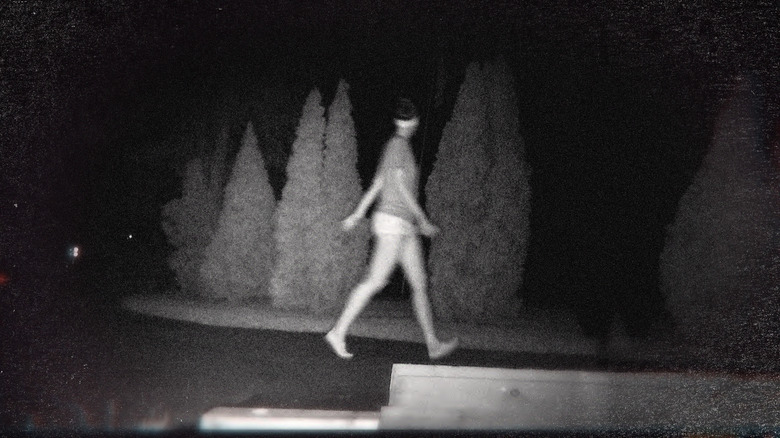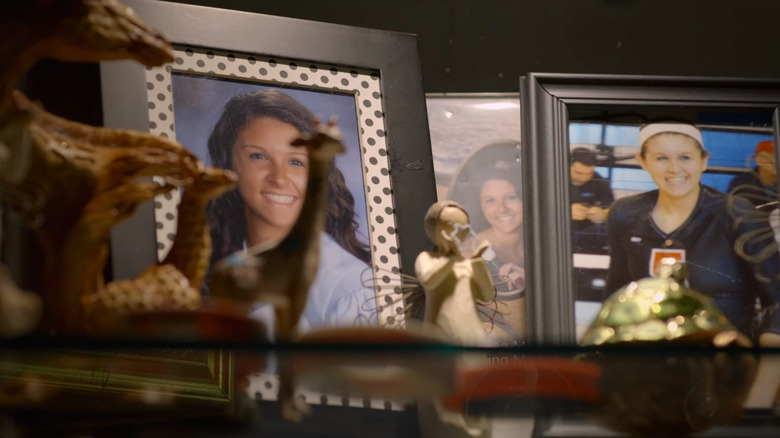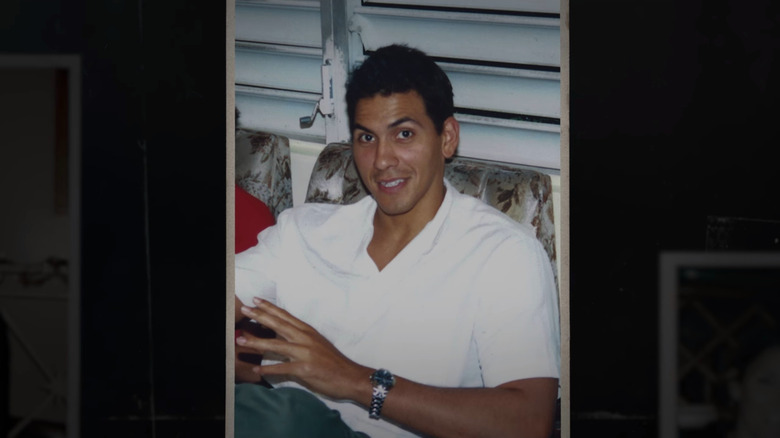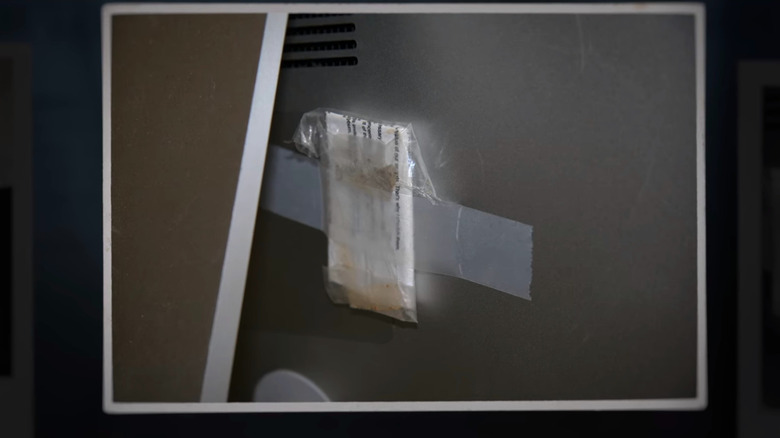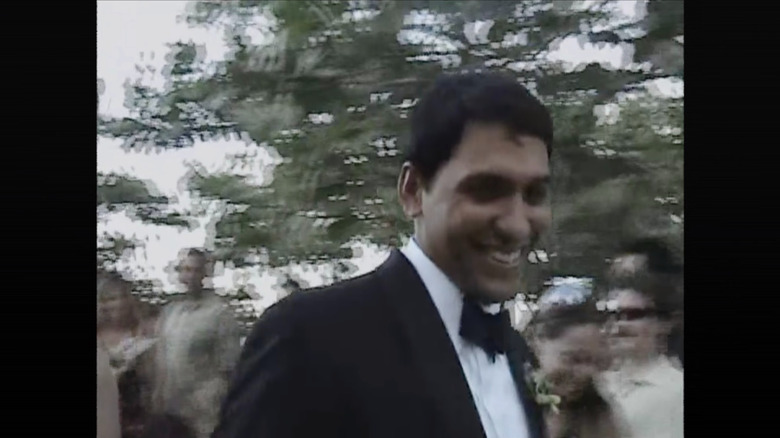Unsolved Mysteries Needs To Talk More About Mental Health
Warning: this post contains discussions of suicide.
"Unsolved Mysteries" recently resumed its official podcast after Netflix's streaming revival of the popular TV show concluded its third volume in November. Our "Unsolved Mysteries" season 3 review calls it "a well-polished addictive piece of TV," and having watched every episode of the Netflix reboot and listened to every episode of the podcast, narrated by Steve French, I would agree that it is very much that. Yet the show has undergone an evolution since the pre-internet days when Robert Stack was hosting it. Rather than multiple segments, each "Unsolved Mysteries" episode now tackles a single case.
If you've seen enough of them, you might begin to notice a pattern with certain episodes. Consider the synopsis of the season 3 premiere, "Mystery at Mile Marker 45." It reads, "Tiffany Valiante, a promising young athlete, is struck by a train four miles from home. But was her death a suicide or something more sinister?"
This is a typical setup for an episode where a death the authorities have labeled suicide is framed in mysterious terms, per the series title. In "Mystery at Mile Marker 45," we see smiling photos and home videos of Valiante, and hear, first and foremost, from her grief-stricken parents, who refuse to believe she died by suicide. That image runs counter to the 18-year-old they thought they knew and still remember as happy, full of life, and volleyball scholarship plans. They've kept their daughter's room just the way she left it, and we see another wall memorial and cabinet shrine to her in their house.
Over the course of the episode, however, other details emerge — and are quickly glossed over — suggesting Valiante could have struggled with mental health, something "Unsolved Mysteries" seems hesitant to meaningfully address.
Tiffany Valiante and Mystery at Mile Marker 45
"Mystery at Mile Marker 45" establishes that, before Valiante was last seen on camera, walking away from her house to somehow be hit by a train, she had a confrontation with a friend who accused her of using her credit card without permission. Valiante denies doing it but then confesses to her mother that it's true, whereupon she's threatened with further exposure to her father. Her mother goes into the house, and when she comes back out, Valiante is gone.
The confrontation with Valiante's friend becomes the basis for one enduring theory that she was kidnapped and killed. Late in the episode, we learn Valiante broke up with her girlfriend right before she died (she reportedly came out six months earlier, another seeming upheaval that's left out), but this event is minimized. "Unsolved Mysteries" doesn't explore its timing as anything more than coincidence.
Without rehashing them all here, the circumstances of Valiante's death could be regarded as suspicious and do merit thorough, open-minded consideration, but what's bothersome about "Mystery at Mile Marker 45" is that it doesn't provide enough of a counterbalance to the murder theory. You could argue that's not the case it's trying to submit in the court of public opinion, but the episode stages reenactments of events that may have never happened and neglects the possibility of concealed emotional turbulence leading to teen suicide, in favor of the assertion that unidentified assailants laid Valiante's body on the train tracks.
"Unsolved Mysteries" can and has led to some breaks in real-life cases, but it's also part of a true-crime ecosystem that thrives partially on stories involving the inexplicable death of a beloved person. The problem arises when it misleads viewers by omitting important details that don't necessarily match the homicide narrative.
Details the episode leaves out
In the 2020s, podcasters, Redditors, and news sites can sometimes crowd-source information in ways that offer a more comprehensive view than what you might see in a TV episode where the talking heads belong mostly to family members, people with a vested interest in preserving the memory of a lost loved one. With "Mystery at Mile Marker at 45," it's only when the viewer researches the case more afterward that a less rose-colored image of Tiffany Valiante comes together.
As The Daily Beast reports, Valiante had been having problems at home before her death, and it was serious enough that child protective services got involved after a physical altercation where Valiante's mother punched her and left her arm bruised. She had also previously removed money from her mother's bank account without consent, which suggests the unauthorized use of her friend's credit card wasn't an isolated incident. Some of Valiante's classmates furthermore indicate that she felt "lonely" and had a history of self-harm, having cut herself on more than one occasion.
With the show being made in cooperation with Valiante's parents, it's understandable that "Unsolved Mysteries" wouldn't want to betray their trust or air a bunch of dirty laundry they wouldn't sign off on. At the same time, it feels disingenuous not to divulge information that could be pertinent to a psychological autopsy of Valiante. This is not to suggest anyone bears responsibility for her death, but it does move past the portrait of a picture-perfect teen and allow for the possibility that Valiante was someone who could have entered a distraught suicide victim's frame of mind.
It's only toward the end that "Mystery at Mile Marker 45" briefly entertains testimony that Valiante was "sad" or even "depressed" and "felt like she could never fit in."
Other unexplained deaths
In "Mystery at Mile Marker 45," we hear the family lawyer's private investigator say, "If you assume that it's a suicide right at the beginning, and then tailor the facts to fit your assumption, everything else after that is suspect." Yet confirmation bias cuts both ways, and the same quote holds true if you assume prima facie that someone's death is a homicide. "Unsolved Mysteries" does this often as it sticks to the point-of-view of shocked and traumatized loved ones who may be in denial about cases that are already solved as much as humanly possible.
"Mystery at Mile Marker 45" is just one recent "Unsolved Mysteries" episode that caters to conspiracy theories without showing serious consideration of mental health issues that could have been at play in a person's death. Two other episodes with similar alliterative titles, "Body in the Bay" and "Lady in the Lake," follow the same template of a missing person found dead in the water. Law enforcement officials deem the deaths a suicide, but the family suspects foul play. It's a familiar refrain that, in the latter case, overshadows admissions that the victim had been "acting very troubled, not herself." There's no mention of a court record detailing "paranoid" behavior and the coroner's presumption of "psychosis."
The podcast two-parter, "The Sudden Departure of Granger Taylor," strategically withholds the reveal that an "eccentric mechanical genius" who claimed to be leaving on an alien space voyage had dynamite access, and the police found a blast site where they identified parts of his truck and human remains. In that episode, it's the victim's mentee/best friend who can't accept his apparent death at face value. Had "Unsolved Mysteries" disclosed the dynamite blast sooner, listeners might have dismissed his interstellar journey as an open-and-shut case.
Rey Rivera and Mystery on the Rooftop
Homicide theories require suspects, and like the "Serial" podcast, "Unsolved Mysteries" isn't above casting suspicion on named individuals, which sometimes mobilizes a gang of armchair sleuths against other friends and relatives of the deceased. Needless to say, the online world isn't a place where people always enjoy the presumption of "innocent until proven guilty."
Looking back on the new "Unsolved Mysteries," an obsession with cases where the manner of death (homicide or suicide) was "undetermined" has been hardwired into its DNA right from the start. The very first episode of the reboot, "Mystery on the Rooftop," serves as a fascinating bookend, in that respect, to "Mystery at Mile Marker 45."
Like Tiffany Valiante, who supposedly walked through the dark despite having a fear of it, Rey Rivera was someone with a reported fear of heights whose death was attributed to a precipitous fall from a hotel roof, consistent with a running jump. On top of Rivera's fear of heights, much is made of how difficult it would be to access the roof. What we're not told is that Rivera and his wife (who remains convinced "There's something bigger, there's something more going on") had already visited that roof to watch the sunset.
Last year, I interviewed the director of "Mystery on the Rooftop," Marcus A. Clarke, though he was promoting another new documentary project and we never got around to talking about "Unsolved Mysteries." Part of what renders his season 1 premiere compelling, though, is that it makes room for other credible voices outside the victim's immediate family, like a local reporter, a retired detective, and an investigative journalist.
Evidence in the victim's own voice, giving a window into their mind, works even better. With Rey Rivera, we have that.
Rivera's note
"Mystery on the Rooftop" devotes about three minutes of its 52-minute runtime to an unusual note Rivera left taped to the back of his computer. It's not a traditional suicide note, but rather what appears to be a letter to the members of an unnamed council, which holds secrets he's privy to, and the power to make people five years younger.
Since Rivera was an aspiring screenwriter, the suggestion has been floated that this note was simply a fragment of writing for some story he envisioned. Yet it addresses specific people, or "players," in his life, or "game." And it reads very much like someone speaking in code of death, for which they expect to be rewarded with houses across the world. There are lines like, "Life is a test," and, "That was a well-played game. [...] But, it was time to wake up."
The note ends with a list of movies, including "The Matrix" and "The Game," two films where the main character jumps off a roof but survives the fall because they're caught up in a simulated reality of some sort. Other movies on the list relate to Freemasonry and secret societies, such as "National Treasure," "The Da Vinci Code," and "Eyes Wide Shut." The latter film notably features Tom Cruise as a doctor who believes he's at the center of a conspiracy to cover up a woman's death, only for a rich patient to come in at the end and burst his bubble with a more mundane explanation for what's really going on.
"Unsolved Mysteries" goes the opposite route with its season 2 premiere, "Washington Insider Murder," simultaneously undercutting its own title and downplaying the possibility that a simple, tragic accident or random act of violence could have resulted in a bipolar man's death.
An FBI counterpoint
Rivera's note was sent to the FBI, and you can read its redacted analysis online via the true-crime podcast The Prosecutors. In "Mystery on the Rooftop," a retired detective — the only one in the homicide department who didn't believe Rivera's death was suicide — gives a secondhand summary of the note's content, essentially shrugging off the FBI's determination as "just an unusual note, but not suicide intent."
There's a lot more to it than that. The FBI's analysis states outright that "the overall themes and specific language in [Rivera's] letter are consistent with someone who suffers from a delusional disorder or bipolar disorder," one "featuring a persistent belief contrary to reality." It then goes on to observe, "Persons with delusional disorder can be highly functional in many areas of their life. In this particular case, the mental illness suffered by the author of the letter may go virtually undetected by family, friends and coworkers."
This is a key detail "Unsolved Mysteries" overlooks, not just in "Mystery on the Rooftop," but in other episodes, like "Mystery at Mile Marker at 45," where loved ones struggle to understand what possible motive an alleged suicide victim could have had. Maybe part of the reason some deaths defy logic is that the person who died wasn't thinking logically and had kept that part of themselves compartmentalized.
The FBI's analysis further notes that Rivera's letter contains "a flight of ideas that could have been written by someone experiencing an untreated manic episode." It recommends that Rivera's family members "be re-interviewed regarding his health." Yet the interviews we see on "Unsolved Mysteries" don't usually probe much deeper than family assertions that a person was happy before they died (as if there might not be some part of their psyche that was inaccessible to family).
Demystifying mental health
Other Netflix docuseries like "Crime Scene: The Vanishing at the Cecil Hotel" have been accused of exploiting mental health tragedies for circus theorizing. "Unsolved Mysteries" has developed an M.O. more like the attorney in "Mystery at Mile Marker 45" who says, "Most of my cases have involved representing victims."
The question is, which victims is it representing: the people who died, or family members left to deal with the fallout of a misunderstood tragedy? Having the testimony of loved ones form the backbone of an episode might appeal to the viewer's sympathies, but if they really want to solve these cases and be respectful of the deceased (not to mention living people who may struggle with the same psychological patterns), the show needs to normalize mental health discussion and be more forthcoming with all the available facts, even ones that are incongruous with a "foul play" hypothesis.
Another source not mentioned in "Mystery on the Rooftop" — but one that's often cited in talk of the Rivera case — is Mikita Brottman's digression-filled book, "An Unexplained Death: A True Story of a Body at the Belvedere." After "Mystery on the Rooftop" aired, Brottman revealed that the makers of "Unsolved Mysteries" learned about the Rivera case through her book, contacted her early on, and interviewed her at length. In the end, they elected not to use any of the footage, which, according to Brottman, "would have closed down a lot of speculation" and "didn't fit with the 'grieving widow' / emotional plotline that the show emphasized."
After thoroughly researching Rivera's death for her book, Brottman, too, reached the conclusion that he had most likely died by unintentional suicide while in the grips of paranoid delusion.
Uncharted headspace
In "An Unexplained Death," Brottman writes, "Rey's friends and family say he never displayed any outward sign of mental illness, but this does not mean he was not mentally ill, just that he had none of the most familiar symptoms." Schizophrenia, she observes, can develop "gradually and then suddenly," with a "slow increase in symptoms," giving way to a "sudden psychotic episode."
We learn from the book, also, that Rivera had been foregoing sleep and exhibiting telltale signs of paranoia. He was under a tight video deadline, "feeling guilty" over his role in a failed financial newsletter, and had amassed $90,000 in debt, which his wife spent ten years paying off. Again, "Unsolved Mysteries" avoids sharing some of this info, though it would establish possible stress factors that could have aggravated his mental state.
The non-Hollywood ending and answer to lingering questions in Rivera's case and others might be a thought too unfortunate for some to bear: namely, that the victim had a dark side and was alone in some uncharted headspace in their final moments. Which is more realistic: that scenario, or one that entails Granger Taylor flying off aboard a spaceship?
One last case study from the "Unsolved Mysteries" archives, "Missing on the Bridge," is the podcast equivalent of "Washington Insider Murder": a rare episode that lightly interrogates mental health, presumably because the victim's family (which has since received closure through an update) had already noticed "concerning changes in her personality and mental state." Fifty-seven-year-old Kim Flint had survived one suicide attempt and may have been off her medication when her SUV hit a guardrail without braking. Though one interviewee prefers the idea of "opportunistic thieves" to a suicide theory, another acknowledges the lurking probability of a "mental health episode." More moments like that are needed.
The mystery of inner lives
In its current incarnation, "Unsolved Mysteries" almost functions more as a form of victim advocacy in some episodes than it does a full and honest documenting of the facts of each case. The show builds trust with the loved ones of people who have lost their lives and gives them a platform to talk about what happened on international streaming TV. Maybe hearing their subjective rationalizations of irrational events is just intended as a starting point.
"Unsolved Mysteries" makes no claims to impartiality and is under no obligation to fully re-litigate the cold cases it exhumes. Nor would it always be possible to do so in a one-hour format. Plenty of documentarians oversimplify or cherry-pick the facts they're going to include to suit their agenda or the narrative they've settled on in the editing room.
By involving the viewer as a potential crime solver, however, "Unsolved Mysteries" puts the audience in the position where it's searching for plausible explanations and deliberating as a jury of sorts. And when the audience realizes that it has been consistently misled, a different kind of trust between show and viewer or jury and advocate breaks down.
There's much to be said for advocacy, but there may also be cases where offering up the one-sided perspective of surviving family members presents a conflict of interest, such that the show does a disservice to actual suicide victims by further sensationalizing their deaths and/or stigmatizing mental illness. When we know the how and it's just a question of why someone died, the real unsolved mystery may just be the inner life that a person kept hidden.
If you or anyone you know is having suicidal thoughts, please call the National Suicide Prevention Lifeline by dialing 988 or by calling 1-800-273-TALK (8255).
